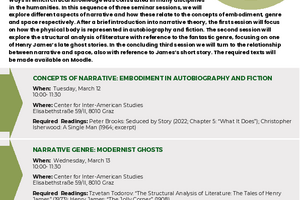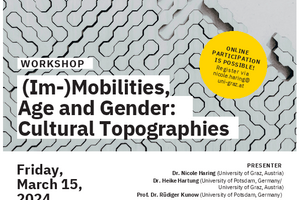The Peril and the Promise of Representing Aging and Old Age
Visions of Aging: Images of the Elderly in Film. Amir Cohen-Shalev. Portland: Sussex Academic Press, 2012. Pp. 140. $66.60 (hardcover) $33.20 (paperback).
Aging, Performance, and Stardom: Doing Age on the Stage of Consumerist Culture. Aagje Swinnen and John A Stotesbury, eds. Vienna: Lit Verlag, 2012. Pp. 195. $37.95 (paperback).
Aging Femininities: Troubling Representations. Josephine Dolan and Estella Tincknell, eds. Newcastle upon Tyne: Cambridge Scholars Publishing, 2012. Pp. xxi + 248. $49.21 (hardcover).
Lost in the dark, wood-paneled bowels of the administration building, I finally wound my way around to the notice announcing “Faculty Contracts.” There to sign papers for my first teaching job as a newly-minted PhD, I eagerly presented myself at the appropriate office where, after only a cursory glance in my direction, the young woman behind the desk asked if she could help me with retirement. Although this encounter ended in mutual laughter, I’ve often wondered how this scene would have played out in the movies, been portrayed on TV, depicted in a painting, written into a novel, or danced in a ballet. Would it have been represented in a way that encouraged us as an audience to laugh at me for disrupting the usual age-based stereotypes by failing to “act my age,” or to cheer me on? Portrayed in a manner that prompted us to laugh at the woman behind the desk for her ageist, and in this case embarrassing, response, or to identify with her? Or possibly depicted in a way that inclined us to chuckle at the uncomfortable recognition of our own unconscious age biases?
According to three recent books on the ways that aging is represented and made culturally visible—Visions of Aging: Images of the Elderly in Film by Amir Cohen-Shalev; Aging, Performance, and Stardom: Doing Age on the Stage of Consumerist Culture, edited by Aagje Swinnen and John A Stotesbury; and Aging Femininities: Troubling Representations, edited by Josephine Dolan and Estella Tincknell—it is more than likely that this scene would have been staged in a way that conformed to a narrowly stereotypical view of both age and gender in which the subjective experience of aging held little sway. Yet, as these books also argue, representations of aging are increasingly marked by their potential to disrupt and transform these stereotypes by challenging the norms of age-appropriate behavior in a manner that bridges the gap between lived experience and social expectation. The subversive potential of such representations is, as Aagje Swinnen argues in the introduction to Aging, Performance, and Stardom, both a perilous and a promising enterprise—perilous owing to the risk of incurring the ageist and hurtful laughter and disdain often aimed at the old who defy stereotypical expectations, yet promising on account of the possibility that such unexpected, age-defying performances may help deconstruct age-based prejudice.
In Visions of Aging, Cohen-Shalev engages with both the peril and the promise of representing old age and aging in cinema by using a case-study approach that highlights the contrast between representations of aging from within, in films made by directors or actors who have actually experienced growing old, and from without, in films made by those for whom old age is as yet an unknown territory. In nine chapters, each focused on a particular film that deals with “the real issues of old age,” such as decrepitude, illness, or death, or on the works of a specific director’s portrayal of old age, such as that of Bergman, Kurosawa, or Sautet, Cohen-Shalev draws on the text of a movie as well as the context of the director’s position in the life span at the time of production to illustrate the way in which both text and context influence a film’s cinematic vision of aging and old age. He further argues that, despite a recent increase in the number of movies dealing with aging or older characters, the majority of popular films continue to provide a distorted, dystopic, and degrading picture of age, and he attributes much of this distortion to the overrepresentation of a midlife perspective on old age. It is this perspective, Cohen-Shalev maintains, that causes most representations of aging to be sanitized and cleansed of the disturbing effects of old age in order to protect viewers from confronting their own deep-seated fears about the uncomfortable social and psychological realities of aging. Yet, he continues, if we are willing to look and listen, old age itself can endow both actors and directors with a unique perspective on life that manifests itself in what he calls “old age style,” a style that is marked by an ambivalence and ambiguity that resists the linearity and closure common to works by younger artists.
One way Cohen-Shalev illustrates his point is by showing how Bergman’s Wild Strawberries, made while the director was thirty-eight and lauded as one of the first serious depictions of old age, turns out to be a midlife fantasy of old age in which the main task of the old is to conduct a life review in order to reach an integrated and meaningful sense of closure. By eschewing any possibility of new growth and development in life, this diminished picture of aging from the outside promotes a truncated idea of disengagement that neglects an examination of the complex and contradictory internal nature of old age. On the other hand, Cohen-Shalev points out, Bergman’s view of old age in Saraband, made when the director himself was in his eighties, is characteristic of old age style in that it both accepts the inherent ambiguity of old age, shown by the protagonist’s simultaneous desire to engage with life and to detach himself from it, and emphasizes the inability of linear and progressive logic to encompass his experience of growing old. Yet, in our youth-oriented culture, says Cohen-Shalev, the unresolved contradictions and lack of closure depicted in Saraband can leave audiences unsettled, stuck in a cultural reluctance to deal with a difficult and discomfiting vision of old age, and hence provides the film industry with little motivation to pursue a deeper vision of aging. Thus, the interface of old age and film can make visible the schism between what Cohen-Shalev calls the phenomenology of aging and its age-contingent cultural representation.
Many of the essays in Aging, Performance, and Stardom, the second volume in the series Aging Studies in Europe, also address our reluctance either to engage with aging’s inherently ambiguous interior reality or to accord its more obvious exterior signs any value in and of themselves. Stressing the performative nature of age and drawing from theories such as Judith Butler’s ideas on gender performativity, Anne Davis Basting’s study of the performative nature of age both on and off stage, and Margaret Gullette’s contention that we are aged by culture, this collection emphasizes the importance of age scripts in determining the implicit norms of age-appropriate behavior and appearance for both men and women. The collection is divided into three sections: The first, Age Performances, focuses on how the professional staging of age is reinterpreted and changes over time. Aging Stars, the second part, discusses the strategies female stars employ to deal with the intersection between their star persona and the roles available to them as the years pass. And the third, Aging in Consumerist Culture, examines how celebrities, along with some who work in fields such as advertising and television talk shows, resist the homogenization of age-related identities and work towards the portrayal of more age-diverse ideals of beauty.
Illustrating resistance to the narrative of aging as decline and to the consumerist disciplines this narrative engenders, in “Sexist Ageing Consumerism and Emergent Modes of Resistance,” Deborah Chambers discusses the effect that attitudes towards the aging female star have on the rest of women in western societies. Arguing that aging within the “body culture” of the West turns the body into a project invested with a “symbolic capital,” the loss of which can render even a star, no less the rest of us, invisible, she traces emerging practices that challenge the unreflexive use of decline ideology in areas such as soft news and advertising. Estella Tincknell focuses more tightly on this potential loss of capital in her chapter on Goldie Hawn, in which she argues that Hawn’s continuing popularity is due not only to the vigilant management of her public persona but also to the misogynistic monitoring of her private body. Even though Hawn’s characters in movies such as Private Benjamin and Swing Shift are designed to be subversively disruptive of patriarchal values and structures, Tincknell explains, their compliance with the hegemonic goals of patriarchy, one of which is to maintain a youthful appearance, is always achieved in the end. By continually deferring the complex state and look of mature femininity, says Tincknell, Hawn can repeat the threatening process of female development and maturation over and over again, thus ironically participating in the disavowal and demonization of growing old as she herself is commended for managing to remain girlish while aging. On the other hand, as Rebecca Feasey asserts in “The Ageing Femme Fatale,” actress Sharon Stone’s attempt to reprise her role as a sexually alluring femme fatale when she was forty-eight was met with the ridicule and pleas for invisibility reserved for “older” women on the screen. Unlike Hawn, whose girlish antics and avoidance of outright female power allow her to postpone recognition of the signs of aging and therefore to resist identification with the cultural aging process that works to effectively marginalize the rest of us, Feasey reads Stone’s re-adoption of the archetypal femme fatale role as a direct challenge to the dominant cultural codes that associate female desirability and sexual activity with youth.
Aging Femininities, an edited collection of essays that critiques and challenges both historical and contemporary images of aging femininity, aims to link feminist cultural theory that critiques dominant representations of older women to the lived experiences of older women. Re-engaging with the work of Simone de Beauvoir and Germaine Greer on the social and cultural invisibility of aging women, this volume also explores the ways in which aging femininity’s newly acquired visibility is moderated by the imperative to “age gracefully,” thus paradoxically continuing to render the undisciplined, older female body both abnormal and abject. The collection is divided into four sections: “Cultural Herstories,” essays that deal with the way that cultural representations of the past can mold understandings of the present; “Regulations and Transgressions,” pieces that explore both the passivity and the performativity of the aging woman; “Problematic Postfeminists?,” essays that see the older woman as an often contradictory “subject-in-process”; and “Divas and Dolls,” contributions that examine the aging female celebrity’s relationship to feminine excess, camp, and irony. Aging Femininities goes beyond film into television, music, art, literature, and personal experience to illustrate how aging studies can profit from a cultural studies approach.
The benefits of this approach are particularly explicit in Abigail Gardner’s“Grit, Glitter and Glamour,” an essay that scrutinizes how Dolly Parton has managed to put off the invisibility that comes with growing older by never “acting” or appearing her age. Through a combination of nostalgia and artifice that works to camouflage the signs of age and arrest her development, Parton presents herself at once as a mature musician, through an appeal to her country roots and lineage, and as a young and playfully sexy woman, through the artificial accentuation of traces of her youth. This dual yet inherently contradictory image, writes Gardner, allows Parton to evoke the façade of her past while simultaneously erasing the look of a present, aging self. According to Sadie Wearing in “Exemplary or Exceptional Embodiment?,” a similar discursive combination of authenticity and artificiality characterizes the celebrity of Helen Mirren. Positioned both as a skilled older performer, through reference to the body of her work, and as a still seductive and alluring vamp, through reference to her “exceptional” physical body, Mirren seems to personify a new version of “successful” aging. Yet, as Wearing points out, her attractive image is also haunted by a discourse of shame, best observed in the scene in Calendar Girls where Annie chastises Mirren’s character Chris for the way her rush to transitory fame has led her to forget the enduring needs of her husband and son. Running counter to the emancipatory tone of the film, this shaming ultimately disciplines the desiring and desirable older woman back into the traditional norms of aging femininity, keeping intact the association between youth and femininity, and again refusing to address either the internal experience or the external manifestations of aging.
The work required to stay visible and embrace aging while simultaneously holding off aging’s effects on one’s mind and body is daunting and far beyond the reach of mere ordinary mortals. For most of us, as Josephine Dolan writes in “A Celebration of Age Festival” in Aging Femininities, to age is to be feminized regardless of biological sex, positioned as vulnerable and as subjects regulated by discourses of respectability that demand the performance of a disciplined and docile body, in need of professional services. Yet, as Dolan shows by her own refusal to be interpellated into the festival’s pathologizing and stereotypical version of aging, growing older can also be staged as a time of renewed authenticity, creativity, and agency. By disclosing her own discomfort with the “clinical gaze” of a festival that purported to celebrate aging (74), Dolan aligns herself with the search for what Cohen-Shalev calls a more promising and “humanizing” vision of old age (17).
Cohen-Shalev’s book offers several examples that illustrate the promise of resistance and creativity in old age, especially in films that focus on the disruption of the normative order of life. His chapter on She’s Been Away, a movie that tells the story of a woman who is released in her late seventies from a mental institution where she had spent sixty years locked away for her willful violation of repressive sexual mores and her contempt for patriarchal authority, centers on the ability of the old to reconstruct a sense of self. Intent on creating some kind of meaning from what could be seen as a wasted life, one for which the process of life review—a midlife idea of the task of the old—would be totally inappropriate, she chooses to stand up to repressive male authority once again in order both to help her niece and to regain a sense of self and purpose she feared she had lost. The ability to maintain an authentic self when both the realities and the perception of old age are undermining it is also the theme of A Woman’s Tale, a movie made by exceptionally age-conscious director Paul Cox and another film in which Cohen-Shalev sees the strength and nonconformity that can characterize old age. Emaciated, frail, and close to death from cancer, both the protagonist Martha and the dying actress who portrays her nevertheless insist on living in the now. Their refusal to let the past either define them or interfere with the moment, Cohen-Shalev points out, is not a denial of old age, but makes visible the struggle the old must endure to live on their own terms and remain active participants in the world despite proximity to death.
The stubborn refusal of the old to allow either their ownpast or youth’s present expectations to define them is particularly well exemplified in E. Ann Kaplan’s essay, “The Unconscious of Age,” in Aging, Performance, and Stardom. Arguing that the characterization of May, a recently widowed older woman who discovers both her repressed sexuality and her sense of self in the film The Mother, forces us to face our own unconscious attitudes towards older people and our own aging, Kaplan commends the movie for attempting to penetrate May’s interior affect and for daring to show her unadorned naked body. The explicit display of aged bodies and the way it challenges the cultural dichotomy of youth and age is also addressed in Christel Stalpaert’s “Staging Age and Aging in The Rite of Spring,” where the continued vitality of old dancers reveals age to be a kind of difference from, rather than a state oppositional to, youth, and in “To Pin Up or Pin Down Women of Age?,” in which Aagje Swinnen argues that Erwin Olaf’s photographs of older women’s bodies enjoins the viewer to consider the possibility that older women can remain vital and sexually attractive. In contrast to articles that describe the age-compliant performances of Hawn and Parton, who remain visible by refusing to confront the stereotypes surrounding age, these essays in Swinnen and Stotesbury’s collection stress performances that draw us beyond ageist stereotypes and into the concept of age as a kind of difference that encompasses the potential for positive change and new beginnings.
In Aging Femininities, the ability of older women to consciously speak back to and subvert the stereotypes that surround them while creating something positive and new becomes personal in Rosy Martin’s essay, “Outrageous Agers: Performativity and Transgression.” Using various photographic techniques that simulate instability, Martin and Kay Goodridge fashion images that emphasize their own aging bodies as sites of change and becoming rather than as static containers consigned to decay and redundancy. By foregrounding parts of the aging female body that produce anxiety—bellies, bosoms, thighs—and re-presenting them in an unorthodox manner, these women manage to subvert entrenched ideas of beauty that tie it to youth. According to Diane Railton and Paul Watson in “Madonna and the Drag of Aging,” Madonna fails to perform aging “correctly” by flouting the imperative to appear both “decorous” and “natural,” making visible both the performative nature and the coercive regulation of aging (198). Similarly, Martin and Goodridge’s refusal to follow the rules exposes the contradictions inherent in asking women to acknowledge their chronological age while simultaneously admonishing them for making efforts to conceal the signs associated with that age. By allowing their flesh to make visible the unstable and performative nature of any categorical concept of age, Martin, Goodridge, and Madonna literally embody both the peril and the promise of aging.
These three books, especially when read consecutively, can leave readers with a much deeper appreciation of both the perilous effects of stereotypical representations of aging on our bodies, minds, and lives as we age, and the promising capacity of art—whether professional or personal—to demolish these stereotypes by allowing representations of the creativity and ability of the aging and the old to surface. Yet, although these books clearly argue for the continued creativity of the old, concepts such as Cohen-Shalev’s proposition that a common old age style characterizes the later works of the directors he studies, or the idea expressed in the essay on W. Barns-Graham in Aging Femininities that old age style represents the culmination of a lifetime of artistic work, are problematic. As Hutcheon and Hutcheon point out in “Late Style(s): The Ageism of the Singular,” to the extent that such concepts impose a generalizing description on individual works that ignores disparities in the life circumstances and developmental paths of artists, those concepts, too, are ageist. They gloss over the fact that creativity is not only an individual attribute that may be recognized and cultivated beginning at any age, but is also a collective property that depends on opportunities for expression and reception from which the old may be excluded (Cruikshank). They also disregard the oppressive effects of age relations, “the system of inequality . . . that privileges the not-old at the expense of the old” (Calasanti and Slevin 1), and thus participate in the subjection of “new” older artists to a “cultural imperialism” (8) that a priori diminishes and devalues their positive and productive contributions in relation to both “new” younger artists and older artists with a lifetime of artistic work behind them.
In addition, the majority of the essays in these volumes demonstrate little lived experience of old age on the part of the author. Only in Aging Femininities do pieces appear that document reactions to ageist cultural expectations in a way that reveals scholarship to be what Ruth Ray would call “passionate”—a performative and creative expression of the intersection of the personal, the professional, and the political that can only be called art (1). Most are emblematic of the systematic exclusion of the old from the academy that western culture demands and that precludes the first-hand study and theorization of the discrimination, oppression, and marginalization experienced by the aging and the old that inhibits more accurate accounts and wider appreciation of the scope of their creative contributions. As Neal King writes in “The Lengthening List of Oppressions” in Age Matters, “only the inclusion of old scholars into the field of study will spread a critical view of ageism among scholars” that will make visible the political-economic bases of the inequalities and exclusions of old age and will lead to a reconstruction of the theories that attempt to contain them (68).
Gilles Deleuze argued in his theory of philosophy and cinema almost thirty years ago that there is no difference between representation and reality, art and life. Artistic images and the theories we construct to explain them therefore have the potential to reshape the world, to create a new truth and a new way of living, and to make a new reality. Both the stereotypical behavior and the rebellious nonconformity described in these books should not be understood, then, only as futile attempts to recapture a lost youth, but also as the struggle for a new truth and a different way of living. These analyses depict attempts to fashion a reality in which to grow old is to remain fully human despite the irreconcilability of the desire to go on living and the inevitable terminality of old age. However, as Cohen-Shalev argues in the final chapter of Visions of Aging and Swinnen posits in the introduction to Aging, Performance, and Stardom, for all the peril and promise involved, humor may be the best, and often the only, response to this existential dilemma. Like the laughter that sorted out the misunderstanding at the end of my “perilous” journey to the elusive “promise” of “Faculty Contracts,” humor has the potential to destabilize the whole notion of acting your age, to disclose the performative nature of age-appropriate behaviors, and to deconstruct the prejudices that sustain them. In the end, as Cohen-Shalev suggests, living into old age itself may be the only way to bridge the gap between lived experience and representation. If that proves true, as much of the content of these books contends, then in the struggle for less perilous lives and more promising representations, old age might just have the last laugh.
Works Cited
- Calasanti, Toni and Kathleen Slevin. Introduction. Age Matters: Realigning Feminist Thinking. New York: Routledge, 2006. 1-17.
- Cruikshank, Margaret. Learning to Be Old. New York: Rowan & Littlefield, 2003.
- Deleuze, Gilles. Cinema 2: The Time Image. Minneapolis: U of Minnesota P, 1989.
- Hutcheon Linda and Michael Hutcheon, “Late Style(s): The Ageism of the Singular.” Occasion: Interdisciplinary Studies in the Humanities 4 (2012). Web. 31 May 2013.
- King, Neal. “The Lengthening List of Oppressions: Age Relations and the Feminist Study of Inequality.” Age Matters. Ed. Toni Calasanti and Kathleen Slevin. New York: Routledge, 2006. 47-74.
- Ray, Ruth. Endnotes. New York: Columbia UP, 2008.
Pamela H. Gravagne, University of New Mexico (pgravagn@unm.edu)





